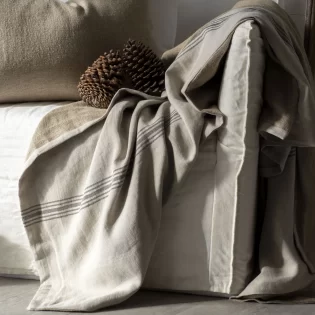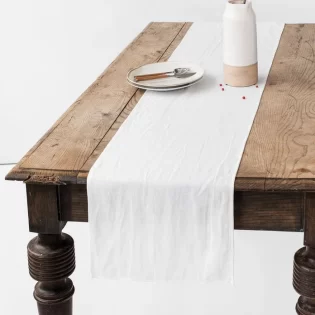In this Article
Share
So, you’ve bought a property to renovate. You’ve picked up the keys. Now what? Where do you begin with planning the interiors or working out your build? For me, it always starts with the place where every designer’s dream takes shape: the mood board.
I can’t recommend The Three Birds Reno School highly enough (not a paid ad, just my personal recommendation) for the more technical lessons behind renovating — things like how much clearance you need around a toilet, how wide a hallway should be, or how to structure your floor plan so it actually flows.
But beyond layout rules and building codes, what the course also gave me was a deep dive into inspiration — your dream home, your aesthetic, the details that feel like you. I created a master mood board early in our restoration of Petit Château and then expanded upon it for every room. It kept me focused on the big picture, but also helped with on-the-spot decisions — like when I was standing in the middle of a furniture showroom trying to decide on a sofa.
Mood Boards, Pinterest, and Galleries
With our Tassie renovation, whenever possible I’d hold up images of potential furniture, fabric swatches, or online finds, in the actual rooms I was designing for. That helped a lot. But, living in Sydney, it wasn’t always realistic — especially when planning for the new-build section of the house where nothing yet existed.
This is where having one overarching mood board, room-by-room Pinterest boards and photo galleries easily accessible on my phone became essential. I could scroll through them anytime, anywhere — for reference, reassurance, or a quick gut check before making a decision.
The Not-So-Fancy Spreadsheet That Saved Me
Alongside the mood boards, I kept a very practical tool: a master renovation spreadsheet. Room-by-room, it listed:
- Finishes (paint colours, flooring, trims, cornices)
- Window treatments and furniture needed
- Electrical details (power points, lighting placement)
- Appliances to order and product specs
- Paint colours for walls, doors, and skirtings, etc.
It acted as both a shopping list and a quick-reference guide for whenever my builder or a tradie asked a question. When you’re juggling a hundred details and the build drags into month six (or twelve), you’ll be glad to have everything in one place. I also created a second room-by-room spreadsheet with direct product links and installation manuals for all major appliances — including the kitchen, powder room, bathroom, and laundry. It saved hours of back-and-forth and meant the trades had everything they needed at their fingertips.
What I’ve Learned
My methods may be low-tech, but they’ve served me well across every renovation I’ve completed. With a solid mood board, well-organised Pinterest folders, and a humble spreadsheet, you’ll feel calmer, clearer, and more confident — and your builder will thank you, too.

Article Source: Petit Chateau (the book) by Karen Miles
Recommended from Shop
Some of our favourite picks from the latest seasonal collection!
Next Articles

The 170-Year-Old Wallpaper Hidden in Our Heritage Cottage Walls
When we began restoring our heritage cottage, Petit Château, we expected a few surprises. But we never imagined the stories that would be told through the layers of wallpaper hidden beneath modern plasterboard.

Could This Be the Cosiest French Consul Collection Yet?
Discover French Consul’s Winter Drop: a limited collection of pure linen cushions, throws, and tabletop pieces in soft chocolate, caramel, and rustic textures — inspired by the French Alps and made for a season of slow, beautiful living.

The Sweetest Craft: The Top 3 Countries for the World’s Finest Chocolate
There are few pleasures as quietly joyful as a piece of truly exceptional chocolate – real chocolate, crafted with patience and artistry. Where is the best chocolate made and who are the top chocolate houses?

The Best Markets in Paris
If you’re planning your own petite balade (stroll!) through Paris, here are the markets I return to again and again.

Beyond Fitness: How Dance Builds Confidence, Strength and Self-Expression
There comes a time in life when movement starts to mean something more. Not just calories burned or steps tracked — but freedom, joy, self-expression. For many women, dance has become the way back into their bodies.

Why So Many of Us Are Feeling Lonely — and How to Reconnect
In a world full of 24/7 connection, many of us are quietly craving something deeper. This Joie editorial explores the loneliness epidemic, why it’s rising, and how we can begin to feel more connected.

The Most Beautiful and Historic Villages of Tasmania
Scattered across Tasmania are some of the prettiest villages in Australia — places where time feels softened and heritage is still very much alive. Here’s a handy travel guide to get you started.

Banquette Seating: A Bistro Icon and Interior Design Favourite
Discover how this classic bistro bench went from café corner to modern design favourite, and why it still captures the charm of slow, beautiful living.






Great tips! I’ve just discovered your Youtube channel, and I love it! Thanks for sharing your content and the day and life of a designer.
Thanks so much for the tips both in the blog and on your YouTube channel. As a new Interior Design student, I find them to be incredibly helpful, interesting, and inspirational. Keep up the great work!
I love reading your blogs and watching your video. I am really impressed by the way you are doing business and I am just inspired by it!